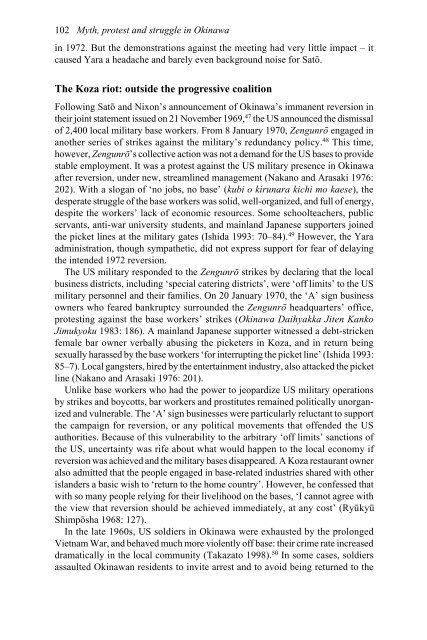Myth, Protest and Struggle in Okinawa
Myth, Protest and Struggle in Okinawa
Myth, Protest and Struggle in Okinawa
Create successful ePaper yourself
Turn your PDF publications into a flip-book with our unique Google optimized e-Paper software.
102 <strong>Myth</strong>, protest <strong>and</strong> struggle <strong>in</strong> Ok<strong>in</strong>awa<br />
<strong>in</strong> 1972. But the demonstrations aga<strong>in</strong>st the meet<strong>in</strong>g had very little impact – it<br />
caused Yara a headache <strong>and</strong> barely even background noise for Satō.<br />
The Koza riot: outside the progressive coalition<br />
Follow<strong>in</strong>g Satō <strong>and</strong> Nixon’s announcement of Ok<strong>in</strong>awa’s immanent reversion <strong>in</strong><br />
their jo<strong>in</strong>t statement issued on 21 November 1969, 47 the US announced the dismissal<br />
of 2,400 local military base workers. From 8 January 1970, Zengunrō engaged <strong>in</strong><br />
another series of strikes aga<strong>in</strong>st the military’s redundancy policy. 48 This time,<br />
however, Zengunrō’s collective action was not a dem<strong>and</strong> for the US bases to provide<br />
stable employment. It was a protest aga<strong>in</strong>st the US military presence <strong>in</strong> Ok<strong>in</strong>awa<br />
after reversion, under new, streaml<strong>in</strong>ed management (Nakano <strong>and</strong> Arasaki 1976:<br />
202). With a slogan of ‘no jobs, no base’ (kubi o kirunara kichi mo kaese), the<br />
desperate struggle of the base workers was solid, well-organized, <strong>and</strong> full of energy,<br />
despite the workers’ lack of economic resources. Some schoolteachers, public<br />
servants, anti-war university students, <strong>and</strong> ma<strong>in</strong>l<strong>and</strong> Japanese supporters jo<strong>in</strong>ed<br />
the picket l<strong>in</strong>es at the military gates (Ishida 1993: 70–84). 49 However, the Yara<br />
adm<strong>in</strong>istration, though sympathetic, did not express support for fear of delay<strong>in</strong>g<br />
the <strong>in</strong>tended 1972 reversion.<br />
The US military responded to the Zengunrō strikes by declar<strong>in</strong>g that the local<br />
bus<strong>in</strong>ess districts, <strong>in</strong>clud<strong>in</strong>g ‘special cater<strong>in</strong>g districts’, were ‘off limits’ to the US<br />
military personnel <strong>and</strong> their families. On 20 January 1970, the ‘A’ sign bus<strong>in</strong>ess<br />
owners who feared bankruptcy surrounded the Zengunrō headquarters’ office,<br />
protest<strong>in</strong>g aga<strong>in</strong>st the base workers’ strikes (Ok<strong>in</strong>awa Daihyakka Jiten Kanko<br />
Jimukyoku 1983: 186). A ma<strong>in</strong>l<strong>and</strong> Japanese supporter witnessed a debt-stricken<br />
female bar owner verbally abus<strong>in</strong>g the picketers <strong>in</strong> Koza, <strong>and</strong> <strong>in</strong> return be<strong>in</strong>g<br />
sexually harassed by the base workers ‘for <strong>in</strong>terrupt<strong>in</strong>g the picket l<strong>in</strong>e’ (Ishida 1993:<br />
85–7). Local gangsters, hired by the enterta<strong>in</strong>ment <strong>in</strong>dustry, also attacked the picket<br />
l<strong>in</strong>e (Nakano <strong>and</strong> Arasaki 1976: 201).<br />
Unlike base workers who had the power to jeopardize US military operations<br />
by strikes <strong>and</strong> boycotts, bar workers <strong>and</strong> prostitutes rema<strong>in</strong>ed politically unorganized<br />
<strong>and</strong> vulnerable. The ‘A’ sign bus<strong>in</strong>esses were particularly reluctant to support<br />
the campaign for reversion, or any political movements that offended the US<br />
authorities. Because of this vulnerability to the arbitrary ‘off limits’ sanctions of<br />
the US, uncerta<strong>in</strong>ty was rife about what would happen to the local economy if<br />
reversion was achieved <strong>and</strong> the military bases disappeared. A Koza restaurant owner<br />
also admitted that the people engaged <strong>in</strong> base-related <strong>in</strong>dustries shared with other<br />
isl<strong>and</strong>ers a basic wish to ‘return to the home country’. However, he confessed that<br />
with so many people rely<strong>in</strong>g for their livelihood on the bases, ‘I cannot agree with<br />
the view that reversion should be achieved immediately, at any cost’ (Ryūkyū<br />
Shimpōsha 1968: 127).<br />
In the late 1960s, US soldiers <strong>in</strong> Ok<strong>in</strong>awa were exhausted by the prolonged<br />
Vietnam War, <strong>and</strong> behaved much more violently off base: their crime rate <strong>in</strong>creased<br />
dramatically <strong>in</strong> the local community (Takazato 1998). 50 In some cases, soldiers<br />
assaulted Ok<strong>in</strong>awan residents to <strong>in</strong>vite arrest <strong>and</strong> to avoid be<strong>in</strong>g returned to the
















